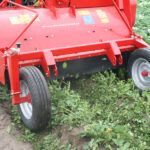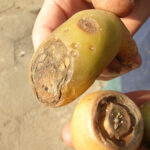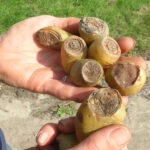Polish name: Wirus A
English name: Potato virus A, PVA
Kod EPPO: PVA000
Gallery
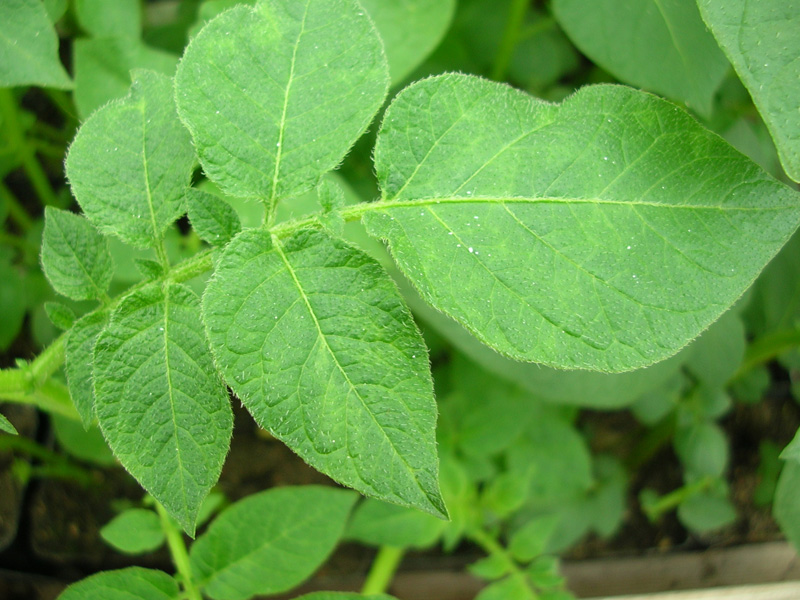
Weak mosaics on leaves
(Photo: S. Wróbel)
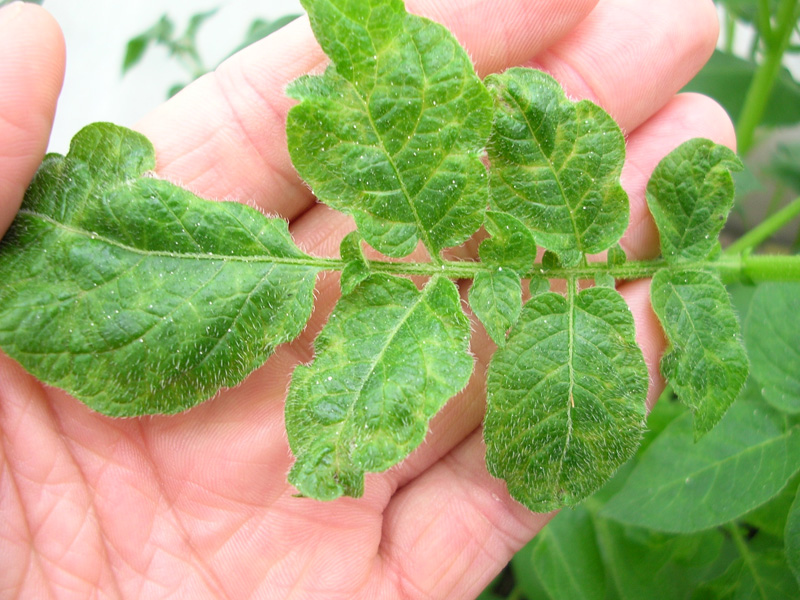
Strong reaction of PVY-infected plants – mosaic and leaf blade wrinkling
(Photo: S. Wróbel)
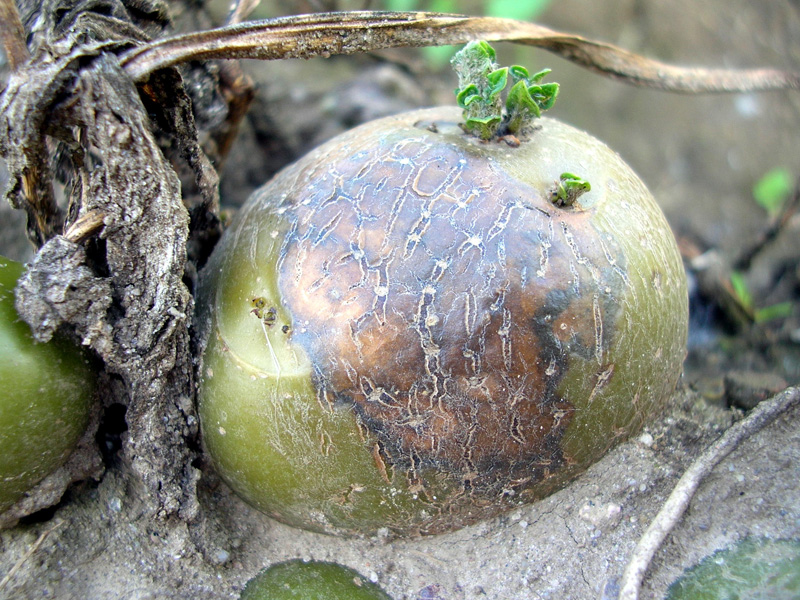
Damage to tubers due to improper use of products containing dichloropropene
(Photo: S. Wróbel)
- 2-rzędowy rozbijacz łęcin Grimme KS 75-2 (fot. S. Wróbel)
- Uszkodzenia bulw po niewłaściwym zastosowaniu środków zawierających dikwat (fot. S. Wróbel)2
- Uszkodzenia bulw po niewłaściwym zastosowaniu środków zawierających dikwat (fot. S. Wróbel)
Characteristics and description of the disease
Wirus A belongs to the same genus of potyviruses (Potyviridae) as PVY. However, its occurrence in Poland is very rare, appearing sporadically only with planting materials imported from abroad. It is seldom encountered in seed potatoes from Polish cultivation. It was first observed in Germany in 1911, but its description was made 20 years later. In Scotland, between 1998 and 2007, it was more common on seed plantations than leaf roll virus, and in some years, its incidence was similar to PVY. A similar situation occurred in Northern Ireland between 2006 and 2012.
The main source of PVA infection is seed potatoes. Although some weeds, such as those from the nightshade family, can also host it, in a temperate climate, it can only survive in seed potatoes over the winter. It is mainly transmitted by aphids, but with mechanical plant damage, it can also be transmitted mechanically with plant sap. The primary vectors of this virus in Poland are the mustard aphid (Aphis nasturtii) and the peach-potato aphid (Myzus persicae). Many non-potato aphids, for which the potato is not a host plant, can also transmit the virus while searching for a suitable plant. A few seconds of feeding is enough for aphids associated with potatoes to effectively transmit the virus, with the optimal acquisition and inoculation feeding times similar to PVY, around 20 seconds. Aphids can maintain their activity for up to 20 minutes after feeding on the plant, although some sources suggest a longer duration, even up to 2 hours.
PVA is not common in Poland, making it a virus of minor economic importance. Due to its similarity to PVY, it is classified as a severe virus in many countries. Potential yield losses can reach up to 40%. Older studies indicate that PVA may reduce yields only when it co-occurs with other viruses, especially potato virus X (PVX). Since 2015, seed material in Poland has been officially evaluated for this virus as well. Current legal regulations do not specify the maximum infection rate of PVA for different quality classes, only the sum for six evaluated viruses (PVY, PVM, PVS, PVA, PVX, PLRV). The highest permissible percentage of bulbs infected with viruses cannot exceed 10% for the lowest class – EU class B.
Symptoms of infection:
Similar to PVY, the severity of PVA symptoms often depends on the susceptibility of varieties and weather conditions. Symptoms are more visible in cloudy weather, and the infection can also be asymptomatic. The most common symptoms during vegetation are:
Mild mosaics on leaves, irregular spots of light and dark green (photo 1A). Other colors, such as brown or yellow, are not associated with viral infection. Mosaics may be more pronounced when PVA occurs in a plant along with PVS or PVX. Leaf puckering (photo 2A) and waving of leaf edges – more common when the virus occurs together with PVX. Protection methods:
One method is to plant resistant varieties. In Poland, there are no field studies on the resistance of potato varieties to PVA. Therefore, no Polish varieties have defined resistance to this virus. However, many foreign varieties have such resistance determined.
There are no effective chemical means for direct control of viruses. Their spread can only be limited. The most effective measure is to maximize spatial isolation (distance from other potato plantations). This is currently most important for protecting healthy seed potatoes from infection originating from plantations of unknown health status. These are usually potatoes grown from own reproductions over many years.
It is also essential to remove sources of infection from the field along with bulbs, i.e., virus-infected plants – negative selection. One should not be too hesitant in this regard, as leaving a suspicious plant in the field in the hope of obtaining higher yields can lead to the disastrous spread of viruses to neighboring plants and, consequently, in seed plantations, degradation or even disqualification.
Controlling aphids on the plantation aims to limit the number of potential virus vectors. This treatment is most effective in limiting the spread of leaf roll virus (PLRV). Significantly less, and sometimes zero, effectiveness is achieved in the case of viruses transmitted by stylet, including PVA. No protective effect should be expected when plants infected with viruses grow on the protected plantation or in its vicinity. The number of aphid control treatments depends on the earliness of the variety and the intensity of aphid occurrence. Usually, 2 to 5 treatments are applied. By using the Prestige Forte 370 FS product on potatoes, the first treatment can be delayed due to the insecticidal action of the substance for the first 6-8 weeks after planting. Additionally, this product protects the plantation against the Colorado potato beetle and soil pests.
A highly effective method of limiting the spread of PVA on potato plantations is to use mineral oil, similar to PVY and PVM. To achieve the desired effectiveness, weekly treatments with mineral oil sprays (e.g., Olemix 84 EC, Sunspray 850 EC) are recommended. The treatments should begin when the plantation has about 80-90% plant emergence. The recommended oil dose is 7 l/ha. This is currently the only, and very effective, chemical method of limiting the spread of PVA on seed potato plantations. In commercial production, exchanging seed material for healthy certified material every 2-4 years is much cheaper.
A very effective method of limiting the downward movement of viruses from the above-ground part to the bulbs is early topping. This procedure is commonly performed in seed plantations. In commercial production, its effectiveness in limiting bulb infection with A virus is much lower due to the significantly later timing of its execution.
Three methods are commonly used in practice:
Mechanical method:
The mechanical method involves physically breaking down the above-ground part of the potato. Special 2-, 4-, or 6-row devices mounted on a tractor’s three-point hitch, driven by a power take-off, are used for this purpose (photo 1mech). The device has a system of rotating blades (beaters) adapted to the shape of the stems. It is best to leave stem residues about 10 cm long. Setting the cutting elements too low can damage the top layer of stems, exposing and damaging the bulbs. It also promotes secondary plant regrowth, especially in conditions of high humidity (rainfall). This is significant in the case of seed crops, as new regrowth is vulnerable to viral infections. Leaving stems too long significantly extends the drying time and also promotes regrowth. It is important not to use this method on plantations strongly affected by late blight due to the high risk of spreading spores with plant residues.
Chemical method:
The chemical method, commonly known as desiccation, involves applying appropriate preparations in the form of a spray to the plants, causing them to dry out. Applying the substance in inappropriate weather conditions can contribute to defects in the bulbs. This is particularly important when growing potatoes for food processing (chips and fries). Research from abroad indicates that during prolonged drought, spraying with Reglone 200 SL or its equivalent at the full single dose may cause internal discoloration of the pulp on some varieties. Contact of the bulbs with this substance can also cause significant damage. Such situations may occur when the bulbs are very shallowly located in the furrow, and after treatment, heavy rain washed the preparation from the stems to the bulbs in the soil. For the best results, it is recommended to use split doses. The first dose is intended to destroy the upper leaf mass so that in the second treatment, the substance can accurately cover the exposed stems. The second half of the recommended dose should be applied 3-6 days after the first treatment. The speed of absorption of substances by leaves and stems varies and depends, among other things, on the soil on which the potatoes grow. They are most quickly absorbed by plants growing on heavier soils (clay, loamy sand). In the case of Reglone 200 SL, rainfall 15 minutes after application does not significantly affect its effectiveness, while after using the Basta 150 SL preparation, 4 hours of rain-free weather are required, according to the label.
Mechanical-chemical method:
The most advantageous method due to the speed of leaf petiole drying and the effectiveness of limiting bulb infection with viruses. It involves combining both of the above-described methods. After breaking the stems and leaving slightly longer stem sections (15-25 cm), a desiccant spray should be applied at a reduced dose. The drying of the stems after using this method is the fastest (Fig. 4).
Fig. 4. The rate of leaf petiole drying depending on the applied method (source: S. Wróbel, Biul. IHAR 237/238/2005)
Compiled by: Dr. hab. Sławomir Wróbel

